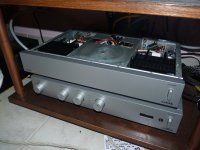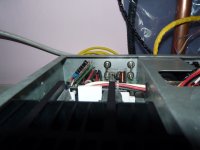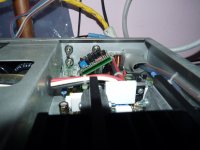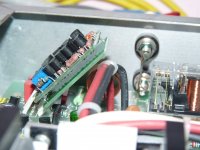I modified my second Audiolab 8000p using Burson Audio opamps as a direct replacement over the Burr Brown opa134 it had.
I recommend them 100%. Results are outstanding, it is a killer amp now. Total control in every sound aspect.
I recommend them 100%. Results are outstanding, it is a killer amp now. Total control in every sound aspect.
Attachments
Also had the pleasure of using those discrete opamps, excellent sonics but the turn off is their a bit pricey.
Are these the ones that Samuel Groner tested (and found identical to audio-gd OPA-Earth)? Those didn't measure particularly well, and "downgrade" would seem to be a more fitting term.
Are these the ones that Samuel Groner tested (and found identical to audio-gd OPA-Earth)? Those didn't measure particularly well, and "downgrade" would seem to be a more fitting term.
Have you actually listened to them?
I have several and they are very good, definately not a downgrade.
I also use LME49710HA (and 20HA) and these are better VFM than the discrete if not quite as good. The NA versions are exceptional VFM!
Last edited:
I think the price is ok. It is a little bit higher than Burr Brown OPA627 but they come matched & with a lifetime warranty ( all you need to do is post your project to their email address). It took me 30 minutes to solder them . Differences are noticeable immediately.
I have two power amps which are exactly the same so the comparison was accurate.
I have two power amps which are exactly the same so the comparison was accurate.
How does changing out an op-amp give control over sound?
Are you sure you want to be asking that? 😉
Its a signal amplifier in the audio path. Dependant on design, it could be a unity gain buffer, an amplifier or form part of a filter circuit. Either way the audio passes right through it.
It is quite common to spread rumours that he found them identical to audio-gd OPA-Earth.
What i'm trying to say is that : In 2 identical power amps, one has the opa627 installed & the other has Burson inside. The one with the Burson outperformed the one with the well known 627 (which is still a good one).
You have to do it yourself in order to make conclusions.
I've done it & i recommend it to you .
What i'm trying to say is that : In 2 identical power amps, one has the opa627 installed & the other has Burson inside. The one with the Burson outperformed the one with the well known 627 (which is still a good one).
You have to do it yourself in order to make conclusions.
I've done it & i recommend it to you .
Are these the ones that Samuel Groner tested (and found identical to audio-gd OPA-Earth)? Those didn't measure particularly well, and "downgrade" would seem to be a more fitting term.
Last edited:
It is quite common to spread rumours that he found them identical to audio-gd OPA-Earth. He sells his own designed opamps
No, he doesn't. He gives away fully developed designs (schematics, board layouts, theory of operation) and measurement data. He doesn't sell that stuff and doesn't appear to have any agenda to bias his results. Samuel's measurement technique is well-documented and very well done.
Steady on guys, let's not even go down this route......again!
I have several sets of Burson Opamps they are incredible. I run them in my pre amp stage and also in my cdp I/V. I've been absolutely impressed with their results.
First post says to me here we have someone who is well pleased with the results of their outlay and effort looking to share their experience with the community. Sure everyone is entitled to their own opinion and a balanced view makes the thread valuable but what I would say is that if you have never tried burson opamps, you are simply not entitled to have an opinion!!! If you tried but didn't like, by all means contribute to the debate.
What I will say to vmed_cha_gr is nice work and enjoy!
I have several sets of Burson Opamps they are incredible. I run them in my pre amp stage and also in my cdp I/V. I've been absolutely impressed with their results.
First post says to me here we have someone who is well pleased with the results of their outlay and effort looking to share their experience with the community. Sure everyone is entitled to their own opinion and a balanced view makes the thread valuable but what I would say is that if you have never tried burson opamps, you are simply not entitled to have an opinion!!! If you tried but didn't like, by all means contribute to the debate.
What I will say to vmed_cha_gr is nice work and enjoy!
Last edited:
Are you sure you want to be asking that? 😉
Its a signal amplifier in the audio path. Dependant on design, it could be a unity gain buffer, an amplifier or form part of a filter circuit. Either way the audio passes right through it.
Sorry I was jumping the gun! What is control over sound?
I beleive here its used here figuratively.
My interpretation is that the sound is tighter and more accurate than with the stock opamps.
Its fairly easy to start messing with opamp rolling to see if you can hear the effects. As previously pointed out the LME49720, LME49760 and LM4562 are all dual opamps with very little cost which will dramtically improve the audio expecially when used with a sensible choice of caps on the voltage supply rails. You could fit sockets and just roll opamps in and out to see the effects. Within reason and depending on application you only need to make sure you have either a singel or dual opamps as the pin outs are different. You can alway ask here if you are unsure
The change to Burson fully descrete opamps will only usually come after some opamp rolling to convince you of the merits. I didnt spend out for a dual & 2 single sets without some investigation!!!
My interpretation is that the sound is tighter and more accurate than with the stock opamps.
Its fairly easy to start messing with opamp rolling to see if you can hear the effects. As previously pointed out the LME49720, LME49760 and LM4562 are all dual opamps with very little cost which will dramtically improve the audio expecially when used with a sensible choice of caps on the voltage supply rails. You could fit sockets and just roll opamps in and out to see the effects. Within reason and depending on application you only need to make sure you have either a singel or dual opamps as the pin outs are different. You can alway ask here if you are unsure
The change to Burson fully descrete opamps will only usually come after some opamp rolling to convince you of the merits. I didnt spend out for a dual & 2 single sets without some investigation!!!
Last edited:
Steady on guys, let's not even go down this route......again!
I have several sets of Burson Opamps they are incredible. I run them in my pre amp stage and also in my cdp I/V. I've been absolutely impressed with their results.
Post one says to me here we have someone who is well pleased with the results of their outlay and effort looking to share their experience with the community. Sure everyone is entailed to their own opinion and a balanced view makes the thread valuable but what I would say is that if you have never tried burson opamps, you are simply not entitled to have an opinion!!! If you tried but didn't like, by all means contribute to the debate.
What I will say to vmed_cha_gr is nice work and enjoy!
I have never use those boards, so I can not say if they make a big difference in the sound or not. But I can only say I would never use "extras" in my diy amps. I always try to make it as simple as possible. as long as an amp is well designed, I do not think I will need one of those. The fewer parts that the signal pass through, the better it is. Fewer parts means fewer problems!. But that it is just my opinion, Most the time I am wrong!!!
Not sure these are extra's at all!!!!!!
In my CD960, the whole output stage was replaced with a single burson.
What do you think is inside a chip type opamp?????? I count 11 transistors in a "simplified" AD797 schematic 🙄
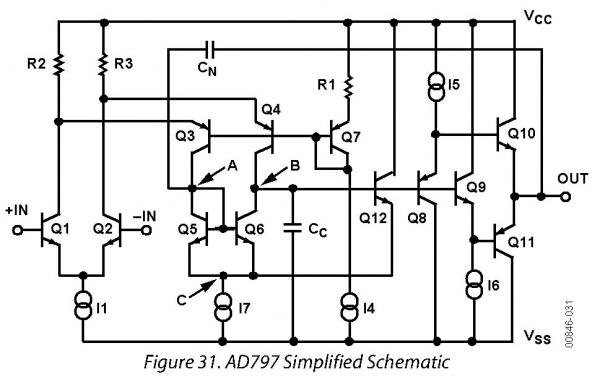
In my CD960, the whole output stage was replaced with a single burson.
What do you think is inside a chip type opamp?????? I count 11 transistors in a "simplified" AD797 schematic 🙄

Not sure these are extra's at all!!!!!!
In my CD960, the whole output stage was replaced with a single burson.
What do you think is inside a chip type opamp?????? I count 11 transistors in a "simplified" AD797 schematic 🙄
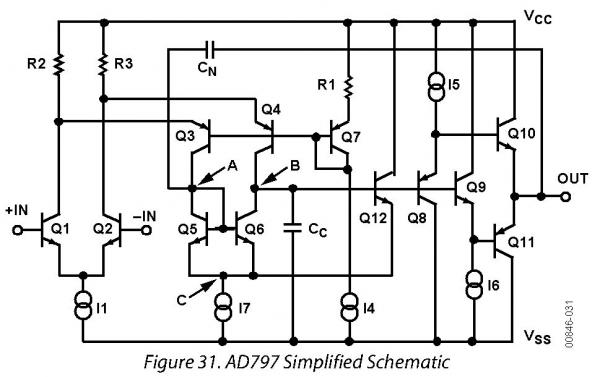
There are more. The current sources are also made with transistors.
Plus overheat and short-circuit protection.
Hoe does one determine that one component outperforms another, is it different, is it placebo, or is it complexity that boggles the mind or is it price? What is the definition of out-performance?
Thanks. It worked great on my setup & wanted to share this.
Steady on guys, let's not even go down this route......again!
I have several sets of Burson Opamps they are incredible. I run them in my pre amp stage and also in my cdp I/V. I've been absolutely impressed with their results.
First post says to me here we have someone who is well pleased with the results of their outlay and effort looking to share their experience with the community. Sure everyone is entitled to their own opinion and a balanced view makes the thread valuable but what I would say is that if you have never tried burson opamps, you are simply not entitled to have an opinion!!! If you tried but didn't like, by all means contribute to the debate.
What I will say to vmed_cha_gr is nice work and enjoy!
perceptual tests with good blinding, controls - requires at least 2 complete "blueprinted" audio components to sub the op amps in one, rapidly switch between the audio components' outputs to make use of our much higher resolving short term memory
clearly the effort involved in valid perceptual testing means good benchtop testing with "prosumer" soundcard or better is needed to make sure that levels, frequency response match - that you haven't broken something during the swap, that the new part doesn't oscillate (really requires oscilloscope with BW >> than op amp GBW)
it is curious why anyone believes the last decade's premium op amps built on GHz vertical transistor, isolated processes with better than 1% Gummel parameter matching designed by institutions with deep knowledge, investments in their design teams, interaction with process engineers motivated by $ billion markets in telcom, medical imaging can be bettered by a lone wolf autodidact using 30 year old through hole discrete parts
my personal designs use 2 or more op amps in multiloop composite amplifier per traditional single op amp application
lets you use best in class input specd devices (SiGe, linearized diff pair, or fet input) with best in class output devices (100 MHz CFA DSL driver chips with 100s mA current output, -90 dB distortion at MHz)
the input op amp “isn’t doing any work” – all of its gain is available to correct the already excellent CFA output op amp
clearly the effort involved in valid perceptual testing means good benchtop testing with "prosumer" soundcard or better is needed to make sure that levels, frequency response match - that you haven't broken something during the swap, that the new part doesn't oscillate (really requires oscilloscope with BW >> than op amp GBW)
it is curious why anyone believes the last decade's premium op amps built on GHz vertical transistor, isolated processes with better than 1% Gummel parameter matching designed by institutions with deep knowledge, investments in their design teams, interaction with process engineers motivated by $ billion markets in telcom, medical imaging can be bettered by a lone wolf autodidact using 30 year old through hole discrete parts
my personal designs use 2 or more op amps in multiloop composite amplifier per traditional single op amp application
lets you use best in class input specd devices (SiGe, linearized diff pair, or fet input) with best in class output devices (100 MHz CFA DSL driver chips with 100s mA current output, -90 dB distortion at MHz)
the input op amp “isn’t doing any work” – all of its gain is available to correct the already excellent CFA output op amp
- Status
- Not open for further replies.
- Home
- Amplifiers
- Solid State
- BURSON SINGLE AUDIO OPAMPS ! ONE OF THE GREATEST !
